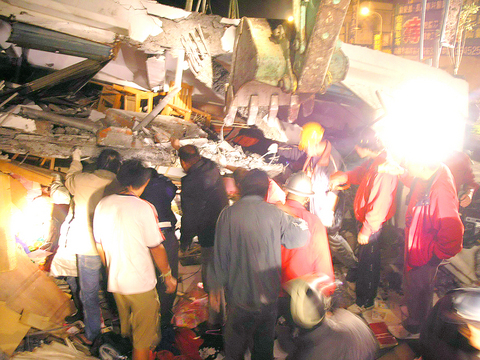Two major earthquakes rocked Taiwan last night, collapsing at least three buildings and killing at least one person in the southern portion of the country.
Phone lines and power were cut in many areas of southern Taiwan. At press time, reports were filtering in detailing the damage and TV footage showed rescue workers attempting to locate people suspected to have been buried in rubble.
A Ministry of the Interior spokesperson earlier said no reports of casualties had been received at press time, but that given the severity of the quakes, casualties were expected.

PHOTO: KUO FANG-CHI, TAIPEI TIMES
The first quake measured 7.2 on the Richter scale according to the US Geological Survey, but Taiwan's Central Weather Bureau said it measured 6.7. There was no explanation for the difference in the measurements.
The first tremor hit at 8:26pm, and the weather bureau said its epicenter was 21.8km southwest of Hengchun Township (恆春) in Pingtung County near the southernmost tip of Taiwan. It occurred 22km under the sea.
The second tremor hit about eight minutes later, with its epicenter 12km west of Fangliao Township (
The second quake's epicenter was only 27.9km southeast of Kaohsiung, the nation's second-largest city.
The quakes knocked down two apartment buildings in Hengchun, burying 11 people in the rubble. At press time, the body of a man had been recovered and four people rescued, while six people were still trapped.
Cable news station TVBS said that two children and two adults were pulled from the rubble of collapsed structures in Pingtung City, and that a total of three apartment buildings in the city had collapsed.
The station also reported that firefighters were fighting a blaze caused by the earthquake at a third apartment building.
A safety valve at an oil refinery in Talin (
One of the reactors at the nearby Third Nuclear Power Plant was briefly shut down because of a malfunction, apparently in connection with the earthquake.
Although the earthquake shook all of Taiwan, northern counties were not reporting damage or casualties, and there were no reports of damage at the Hsinchu Science-Based Industrial Park.
Meanwhile, the Taiwan Railway Administration ordered trains operating south of Changhua County to reduce speed. Trains operating in the vicinity of Hengchun, including the Southern Link Line to Taitung and the east coast, were canceled.
The Taiwan High Speed Rail Corp said that one of its trains was operating when the earthquake occurred. The train immediately activated its braking system and stopped somewhere between Tainan County and Tsoying (左營) in Kaohsiung City.
NO TSUNAMI
Japan's Meteorological Bureau warned that a potential 1m tsunami could be triggered by the quake and might be heading toward the east coast of the Philippines.
Philippine authorities later said there was little likelihood of the tsunami reaching its shores, before the alert was lifted before 11pm.
LOCAL SCENE
TV networks showed pedestrians in Tainan taking cover as the earthquake hit, while Pingtung County was shaken by aftershocks that knocked out mobile phone communications.
A road near an elementary school in southern Taiwan, meanwhile, split open, while Kaohsiung authorities scrambled to respond to fire alarms around the city.
Two more aftershocks of magnitude 5.2 followed at 8:40pm and 10:53pm, and then another at 11:41pm that measured at 5.5 and was felt in Changhua County.
Hotels in Kenting, a beach resort township at the southern tip of the Hengchun Peninsula, were evacuated during the earthquake, according to a hotel worker interviewed by TVBS. No casualties were reported at that location.
A receptionist surnamed Ko at the Splendor Hotel in downtown Kaohsiung told the Taipei Times by telephone that the earthquake had not interfered with the hotel's operations, and that no evacuation had taken place.
"There was a bit of shaking, but even though the Splendor's a tall building, it's designed to withstand earthquakes. A lot of our guests were concerned, but we explained the situation to them and there was no panic here," Ko said.
Cracks in the Kaoping Bridge -- which connects Kaohsiung and Pingtung cities and is part of a major transport artery -- appeared in the wake of the earthquakes, sparking concerns of another collapse of the structure. The bridge collapsed in 2000, injuring 22 people, because of poor maintenance.
Yesterday's quakes were felt throughout the nation. They swayed buildings and knocked objects off the shelves as far away as Taipei.
Taiwan, which lies near the junction of two tectonic plates, is regularly shaken by earthquakes.

People can preregister to receive their NT$10,000 (US$325) cash distributed from the central government on Nov. 5 after President William Lai (賴清德) yesterday signed the Special Budget for Strengthening Economic, Social and National Security Resilience, the Executive Yuan told a news conference last night. The special budget, passed by the Legislative Yuan on Friday last week with a cash handout budget of NT$236 billion, was officially submitted to the Executive Yuan and the Presidential Office yesterday afternoon. People can register through the official Web site at https://10000.gov.tw to have the funds deposited into their bank accounts, withdraw the funds at automated teller

PEACE AND STABILITY: Maintaining the cross-strait ‘status quo’ has long been the government’s position, the Ministry of Foreign Affairs said Taiwan is committed to maintaining the cross-strait “status quo” and seeks no escalation of tensions, the Ministry of Foreign Affairs (MOFA) said yesterday, rebutting a Time magazine opinion piece that described President William Lai (賴清德) as a “reckless leader.” The article, titled “The US Must Beware of Taiwan’s Reckless Leader,” was written by Lyle Goldstein, director of the Asia Program at the Washington-based Defense Priorities think tank. Goldstein wrote that Taiwan is “the world’s most dangerous flashpoint” amid ongoing conflicts in the Middle East and Russia’s invasion of Ukraine. He said that the situation in the Taiwan Strait has become less stable

CONCESSION: A Shin Kong official said that the firm was ‘willing to contribute’ to the nation, as the move would enable Nvidia Crop to build its headquarters in Taiwan Shin Kong Life Insurance Co (新光人壽) yesterday said it would relinquish land-use rights, or known as surface rights, for two plots in Taipei’s Beitou District (北投), paving the way for Nvidia Corp to expand its office footprint in Taiwan. The insurer said it made the decision “in the interest of the nation’s greater good” and would not seek compensation from taxpayers for potential future losses, calling the move a gesture to resolve a months-long impasse among the insurer, the Taipei City Government and the US chip giant. “The decision was made on the condition that the Taipei City Government reimburses the related

FRESH LOOK: A committee would gather expert and public input on the themes and visual motifs that would appear on the notes, the central bank governor said The central bank has launched a comprehensive redesign of New Taiwan dollar banknotes to enhance anti-counterfeiting measures, improve accessibility and align the bills with global sustainability standards, Governor Yang Chin-long (楊金龍) told a meeting of the legislature’s Finance Committee yesterday. The overhaul would affect all five denominations — NT$100, NT$200, NT$500, NT$1,000 and NT$2,000 notes — but not coins, Yang said. It would be the first major update to the banknotes in 24 years, as the current series, introduced in 2001, has remained in circulation amid rapid advances in printing technology and security standards. “Updating the notes is essential to safeguard the integrity